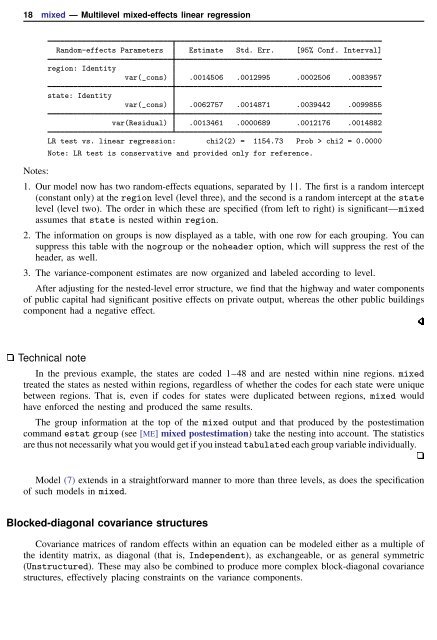mixed - Stata
mixed - Stata
mixed - Stata
You also want an ePaper? Increase the reach of your titles
YUMPU automatically turns print PDFs into web optimized ePapers that Google loves.
18 <strong>mixed</strong> — Multilevel <strong>mixed</strong>-effects linear regression<br />
Random-effects Parameters Estimate Std. Err. [95% Conf. Interval]<br />
region: Identity<br />
state: Identity<br />
var(_cons) .0014506 .0012995 .0002506 .0083957<br />
var(_cons) .0062757 .0014871 .0039442 .0099855<br />
Notes:<br />
var(Residual) .0013461 .0000689 .0012176 .0014882<br />
LR test vs. linear regression: chi2(2) = 1154.73 Prob > chi2 = 0.0000<br />
Note: LR test is conservative and provided only for reference.<br />
1. Our model now has two random-effects equations, separated by ||. The first is a random intercept<br />
(constant only) at the region level (level three), and the second is a random intercept at the state<br />
level (level two). The order in which these are specified (from left to right) is significant—<strong>mixed</strong><br />
assumes that state is nested within region.<br />
2. The information on groups is now displayed as a table, with one row for each grouping. You can<br />
suppress this table with the nogroup or the noheader option, which will suppress the rest of the<br />
header, as well.<br />
3. The variance-component estimates are now organized and labeled according to level.<br />
After adjusting for the nested-level error structure, we find that the highway and water components<br />
of public capital had significant positive effects on private output, whereas the other public buildings<br />
component had a negative effect.<br />
Technical note<br />
In the previous example, the states are coded 1–48 and are nested within nine regions. <strong>mixed</strong><br />
treated the states as nested within regions, regardless of whether the codes for each state were unique<br />
between regions. That is, even if codes for states were duplicated between regions, <strong>mixed</strong> would<br />
have enforced the nesting and produced the same results.<br />
The group information at the top of the <strong>mixed</strong> output and that produced by the postestimation<br />
command estat group (see [ME] <strong>mixed</strong> postestimation) take the nesting into account. The statistics<br />
are thus not necessarily what you would get if you instead tabulated each group variable individually.<br />
Model (7) extends in a straightforward manner to more than three levels, as does the specification<br />
of such models in <strong>mixed</strong>.<br />
Blocked-diagonal covariance structures<br />
Covariance matrices of random effects within an equation can be modeled either as a multiple of<br />
the identity matrix, as diagonal (that is, Independent), as exchangeable, or as general symmetric<br />
(Unstructured). These may also be combined to produce more complex block-diagonal covariance<br />
structures, effectively placing constraints on the variance components.
















